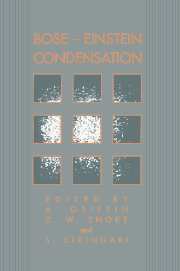Book contents
- Frontmatter
- Contents
- Preface
- Preface to paperback edition
- 1 Introduction: Unifying Themes of Bose–Einstein Condensation
- Part one Review Papers
- Part two Brief Reports
- 20 BEC in Ultra-cold Cesium: Collisional Constraints
- 21 BEC and the Relaxation Explosion in Magnetically Trapped Atomic Hydrogen
- 22 Quest for Kosterlitz–Thouless Transition in Two-Dimensional Atomic Hydrogen
- 23 BEC of Biexcitons in CuCl
- 24 The Influence of Polariton Effects on BEC of Biexcitons
- 25 Light-Induced BEC of Excitons and Biexcitons
- 26 Evolution of a Nonequilibrium Polariton Condensate
- 27 Excitonic Superfluidity in Cu2O
- 28 On the Bose–Einstein Condensation of Excitons: Finite-lifetime Composite Bosons
- 29 Charged Bosons in Quantum Heterostructures
- 30 Evidence for Bipolaronic Bose-liquid and BEC in High-Tc Oxides
- 31 The Dynamic Structure Function of Bose Liquids in the Deep Inelastic Regime
- 32 Possibilities for BEC of Positronium
- 33 Bose–Einstein Condensation and Spin Waves
- 34 Universal Behaviour within the Nozières–Schmitt-Rink Theory
- 35 Bound States and Superfluidity in Strongly Coupled Fermion Systems
- 36 Onset of Superfluidity in Nuclear Matter
- Appendix. BEC 93 Participant List
- Index
24 - The Influence of Polariton Effects on BEC of Biexcitons
Published online by Cambridge University Press: 15 December 2009
- Frontmatter
- Contents
- Preface
- Preface to paperback edition
- 1 Introduction: Unifying Themes of Bose–Einstein Condensation
- Part one Review Papers
- Part two Brief Reports
- 20 BEC in Ultra-cold Cesium: Collisional Constraints
- 21 BEC and the Relaxation Explosion in Magnetically Trapped Atomic Hydrogen
- 22 Quest for Kosterlitz–Thouless Transition in Two-Dimensional Atomic Hydrogen
- 23 BEC of Biexcitons in CuCl
- 24 The Influence of Polariton Effects on BEC of Biexcitons
- 25 Light-Induced BEC of Excitons and Biexcitons
- 26 Evolution of a Nonequilibrium Polariton Condensate
- 27 Excitonic Superfluidity in Cu2O
- 28 On the Bose–Einstein Condensation of Excitons: Finite-lifetime Composite Bosons
- 29 Charged Bosons in Quantum Heterostructures
- 30 Evidence for Bipolaronic Bose-liquid and BEC in High-Tc Oxides
- 31 The Dynamic Structure Function of Bose Liquids in the Deep Inelastic Regime
- 32 Possibilities for BEC of Positronium
- 33 Bose–Einstein Condensation and Spin Waves
- 34 Universal Behaviour within the Nozières–Schmitt-Rink Theory
- 35 Bound States and Superfluidity in Strongly Coupled Fermion Systems
- 36 Onset of Superfluidity in Nuclear Matter
- Appendix. BEC 93 Participant List
- Index
Summary
Abstract
The influence of the radiative decay of excitonic molecules on a possible quasiequilibrium Bose–Einstein condensation (BEC) of excitonic molecule's is examined with respect to the radiative renormalization of the excitonic molecule energy (excitonic molecule Lamb shift). For the excitonic molecule wave function, a Schrödinger equation which contains polariton effects is derived and analyzed. Both the inverse excitonic molecule radiative lifetime γm and the biexciton Lamb shift Δm depend strongly on the total excitonic molecule momentum K. The energy renormalization Δm(K) leads to the excitonic molecule effective mass modification and can result in a camel-back structure at K = 0, which opposes a BEC of excitonic molecules at K = 0.
Introduction
Observations of a quasiequilibrium Bose–Einstein condensation (BEC) of excitonic molecules (EM) have been attempted [1, 2, 3] following its theoretical prediction [4, 5] (for reviews see, e.g. [6, 7]). Recent approaches [8, 9] with high-precision techniques renewed the interest in this phenomenon. Traditionally, one tries to detect BEC of the EMs in luminescence. In the new approach the appearance of coherence in the thermal system of the EMs has been tested by means of four-wave mixing and treated as a fundamental manifestation of BEC. (See the paper by Hasuo et al. in this book.) Both optical methods for the BEC detection imply that the optical transition to the corresponding intermediate exciton (IE) state is dipole-active. In this case the EM state is unstable against optical decay with a “giant” oscillator strength [6].
Information
- Type
- Chapter
- Information
- Bose-Einstein Condensation , pp. 496 - 506Publisher: Cambridge University PressPrint publication year: 1995
